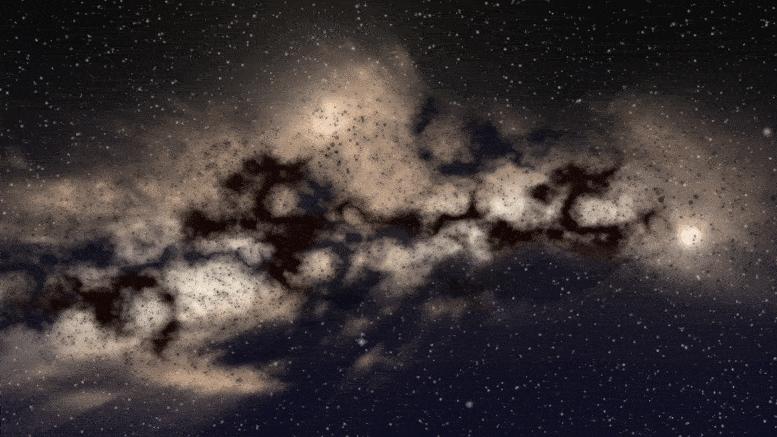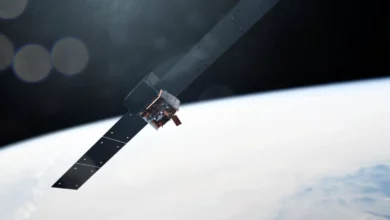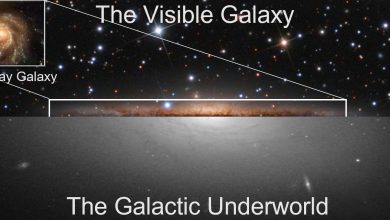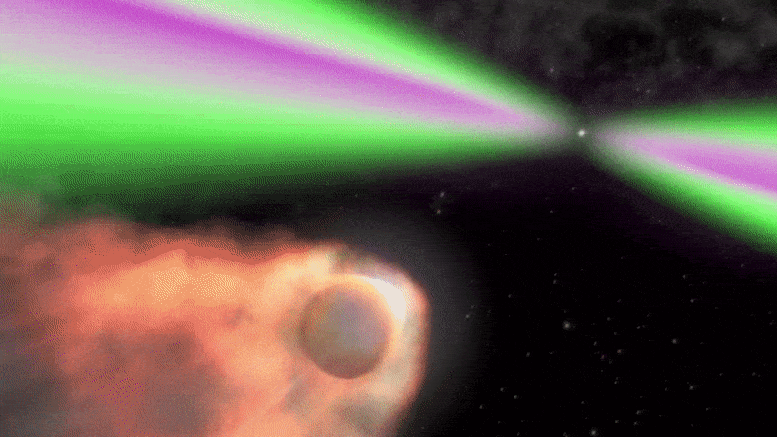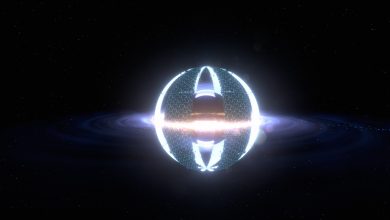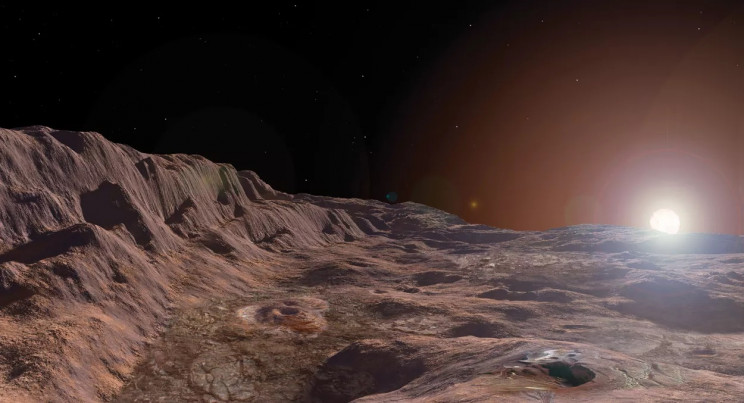
“Welcome to Kandinsky Station! The hour is 06:00 AM Mercury Standard Time (MST), and the local temperature is a balmy 180 K! We hope you had a pleasant journey to the surface via the Spindle, Mercury’s shining tether to space!
“We also hope that you have acclimated to the local gravity. If you are traveling from a low-g point of origin, we recommend you consult the data provided in your virtual pamphlet. If you feel any symptoms of ‘gravity sickness’ please seek immediate medical help.
“Our final destination is Terminator City, where you will be transported in extreme comfort to Mercury’s equator and treated to scenic landscape views amid perpetual twilight!
“A little-known fact about our current location. Like all features on Mercury, the Kandinsky crater takes its name from a famous artist. In this case, it is the Russian painter and abstract art pioneer Wassily Kandinsky who is honored. Our next stop, Prokofiev Station, is named after the Russian-Soviet composer, pianist, and conductor, Sergei Prokofiev.
“A reminder for those making a stopover in Prokofiev Station. While there, be sure to visit the Glass Eye, the most unobstructed view of the largest ice field on the planet. If you time your visit right, you will be able to see the Starry Batch, our featured ice-skating team, as they practice their signature moves!
“If you’re someone who likes to have fun in low-gravity, don’t forget to try out the Aerie. Our qualified instructors will show you how our airfoils and booster packs can give you the gift of flight! We thank you for choosing to make Mercury your vacation destination!
“A reminder to those traveling to either destination seeking employment: please make sure that your documentation is prepared and ready to file with HR upon arrival. We are currently seeking short-order cooks, concierges, and tour guides for full-time and part-time positions. Be sure to have your medical history form completed as well!
“Now, just sit back, relax, and enjoy the Hermian landscape!”
* * *
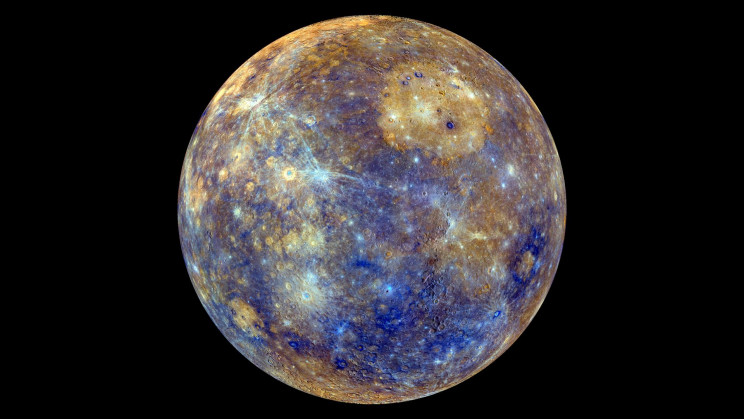
Someday, announcements like this could be a real thing. While the thought of living, working, or visiting a planet like Mercury might sound like something out of science fiction (or completely insane), the idea is grounded in science fact. And with the right strategies and technologies for living in a hostile environment, humans could make a life for themselves on Mercury.
And there would be tangible benefits to having an enduring human presence there. For starters, a local economy could be built around “adventure tourism,” mining, and energy. Mercury is an extreme environment, being the closest planet to our Sun. But it is also rich in ore and precious metals and a tremendous amount of solar power.
But first, the little matter of that “hostile environment” needs to be addressed.
Extreme temperatures
Despite being the closest planet in our Solar System to the Sun, Mercury is surprisingly not the hottest (that honor goes to Venus). This is a result of Mercury having virtually no atmosphere to speak of beyond a tenuous “exosphere” that is believed to have formed through a combination of volcanic outgassing, debris caused by surface impacts, and particles captured from the Sun.
This exosphere is composed of atomic oxygen, sodium, magnesium, atomic hydrogen, helium, and other trace amounts of minerals. However, the pressure does not exceed 5 x 10-15 bar (0.005 picobar), or less than one-trillionth of Earth’s atmospheric pressure at sea level. Because of this, Mercury has no way to retain heat from the Sun and experiences extreme variations in temperature.
Whereas the Sun-facing side will reach temperatures of up to 800 °F (427°C), the dark side will experience lows of up to -279°F (-173°C). The daytime side is also subject to the most intense solar radiation of any planet in the Solar System. And because of its orbit, these daytime and nighttime extremes last for months at a time!
Herein lies another example of Mercury’s extremeness, which is the nature of the planet’s orbit. For one thing, Mercury has the most eccentric orbit of any planet in the Solar System, meaning that it is highly elliptical. Because of this, its distance from the Sun varies between 29 million mi (46 million km) at perihelion and 70 million km (43 million mi) at aphelion.
Really long days!
Its proximity to the Sun also results in a slow orbital period — slightly less than 88 Earth days — and a slow rotational period of 58.646 days. This means that Mercury has a spin-orbit resonance of 3:2, which means that it completes three rotations on its axis for every two orbits around the Sun. However, this does not mean that three days on Mercury lasts as long as two years.
Whereas a “sidereal day” takes over 58 days to occur (it takes 58.65 Earth days for Mercury to turn once around its axis), relative to the background stars, a “solar day” lasts the equivalent of 176 Earth days. If an observer could stand on the dayside of Mercury, it would take 176 Earth days for the Sun to set on them, then rise and return to the same place in the sky. That’s right, on Mercury, a single day lasts almost as long as two years!
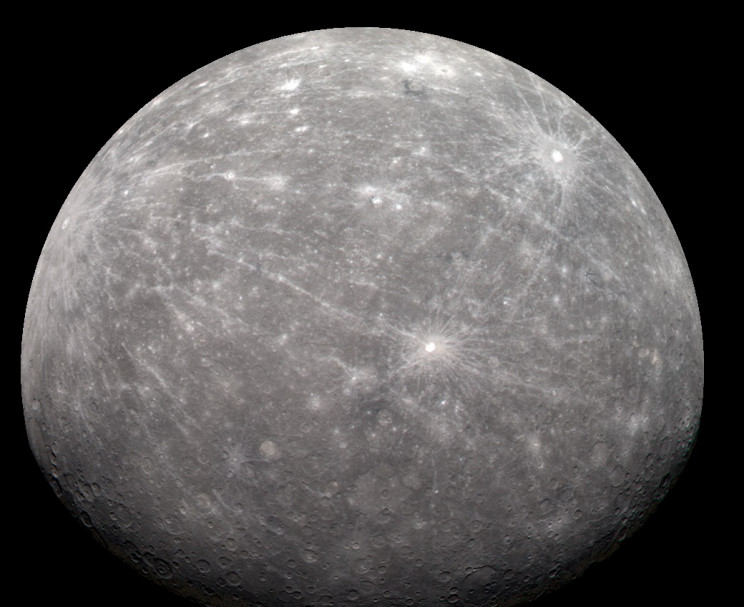
Because of its proximity to the Sun, Mercury receives the most intense solar radiation of all the planets. This means that, even with protection from the temperature, exposure to daylight on Mercury would be lethal, so human settlers would have to stay out of the Sun permanently. Luckily, there’s a range of options that would allow for settlement while ensuring protection from the heat and radiation.
Stay in the shade
If humans hope to live on Mercury someday, they will have to find ways to avoid the Sun at all times. Luckily, the nature of Mercury’s structure and orbit allow for some opportunities for sustainable living. All told, there are three options for creating a Hermian settlement:
Living underground:
Based on data obtained since the 1990s and confirmed by the MErcury Surface, Space ENvironment, GEochemistry and Ranging (MESSENGER) probe, by 2012 scientists realized that stable lava tubes might exist just beneath the surface, similar to what has been observed on the Moon and Mars.
These tubes are remnants of the planet’s geologically active past and, in some cases, are large enough to house an entire city. Within these tubes, temperatures could be kept stable and could even reach 72±2 °F (22±1 °C), the optimal temperature for comfortable living.
Settlements in these tubes would also have the advantage of natural radiation shielding and they could be sealed off and pressurized to create an Earth-like atmosphere — around 100 kPa, with a mix of nitrogen and oxygen gas (a 78:22 mix).
Living on the move:
Another option is to create mobile settlements that are constantly moving west to stay ahead of the Terminator — the boundary between day and night. Since Mercury’s slow rotation and rapid orbit result in 176 days of continual daylight on one side of the planet, the settlements wouldn’t even need to move that quickly and could harvest resources along the way.
Living in a crater:
Alternately, a settlement could be established in permanently shaded regions, such as Mercury’s cratered north pole. These craters serve as “cold sinks,” where temperatures are low enough that water ice can exist. The largest craters — Prokofiev, Chesterton, Tolkien, Kandinski, and Tryggvadóttir — measure between 19.25 mi (31 km) and 70 mi (112 km), which is large enough to fit the greater metropolitan area of New York.
In addition, data obtained by the MESSENGER probe showed that the craters in this region could contain as much as 110 billion to 1.1 trillion tons (1014–1015 kg) of water ice. This ice could be harvested to see to the colonists’ needs, while solar arrays stationed around the crater’s rim would provide a constant supply of power. As a bonus, the ice is believed to be covered by about 7.4 billion cubic yards (5.65 billion m³) of hydrocarbons, which could also be useful.
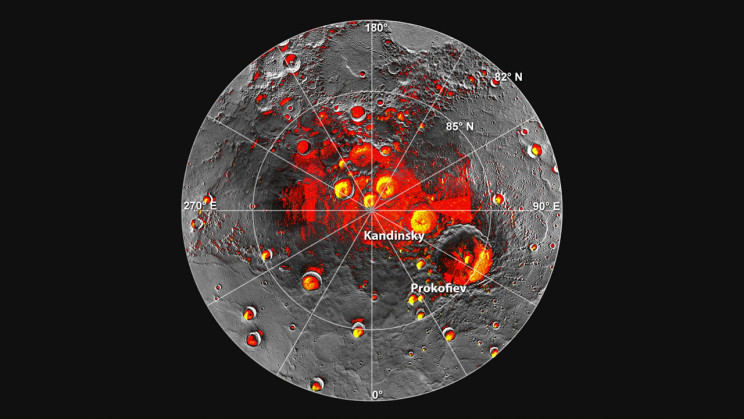
Shown in red are areas of Mercury’s north polar region that are in shadow in all images acquired by MESSENGER to date. Image coverage, and mapping of shadows, is incomplete near the pole. The polar deposits imaged by Earth-based radar are in yellow (from Image 2.1), and the background image is the mosaic of MESSENGER images from Image 2.2. This comparison indicates that all of the polar deposits imaged by Earth-based radar are located in areas of persistent shadow as documented by MESSENGER images. Updated from N. L. Chabot et al., Journal of Geophysical Research, 117, doi: 10.1029/2012JE004172 (2012).
Image Credit: NASA/Johns Hopkins University Applied Physics Laboratory/Carnegie Institution of Washington/National Astronomy and Ionosphere Center, Arecibo Observatory
Once harvested, this water could be used as a source of drinking and irrigation water to create oxygen gas and rocket fuel. Combined with a steady supply of solar energy, which could be directed into the crater’s interior by mirrors positioned around the rim, agricultural operations would be possible as well.
Within a polar crater, habitable enclosures could be built using “paraterraforming” — a concept developed by British mathematician Richard Taylor in 1992. In a paper titled “Paraterraforming – The Worldhouse Concept,” Taylor described how a pressurized enclosure could be placed over a usable area to create a self-contained atmosphere.
This would include pumping in a breathable atmosphere and melting the ice to create atmospheric water vapor. Eventually, the ecology inside the dome would change and create a livable habitat, complete with its own water and carbon cycle. Alternately, the water could be evaporated, and oxygen gas created through long-term exposure to solar radiation (a process known as photolysis).
Minerals, energy, and more!
Well, that covers all the hazards, now let’s talk about the benefits! In addition to the abundant volatile elements like water ice, Mercury receives six and a half times as much solar energy as Earth. This solar energy could be tapped as an abundant power source for settlements on the surface. But with a constellation of solar satellites, this energy could also be harnessed for export.
Engineers are currently looking into space-based solar power as a means of addressing climate change. By placing arrays in orbit, where they can gather solar energy twenty-four hours a day without interruption and are not subject to weather or seasonal change, humanity would have access to clean, abundant, renewable energy.
A constellation of satellites in orbit around Mercury (or at the Mercury-Sun Lagrange Points) could harvest tremendous amounts of solar energy. This energy could then be beamed to the Earth-Moon system and other locations with microwave lasers (or “masers”). Mercury would thenceforth be seen as the “power plant” of the Solar System.
Mercury is also incredibly rich in valuable metals and minerals. Similar to the other rocky planets (Venus, Earth, and Mars), Mercury is composed of silicate minerals and metals differentiated into a silicate mantle and crust surrounding a metallic core (composed mainly of iron-nickel).
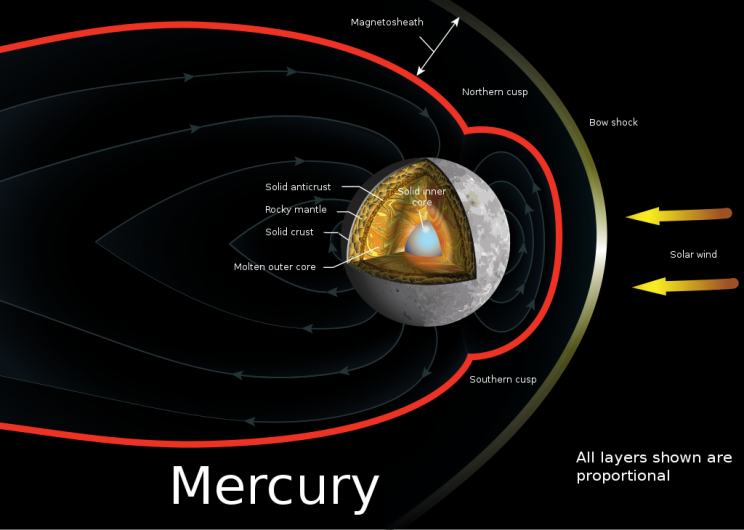
Mercury’s core makes up a much larger percentage of its diameter and volume than the other rocky planets. Based on the latest data, geologists estimate that the crust and mantle are 22 mi (35 km) and 310 – 430 mi (500 – 700 km) thick, while the core measures an estimated 2578 mi (4,148 km) in diameter. This means that the core region accounts for 85% of the planet’s size.
The core itself is differentiated into three layers. The innermost is a solid core composed of iron-nickel, surrounded by a molten liquid core layer, surrounded by an iron sulfide outer core layer. This structure is what gives Mercury the second-highest density of all the planets (after Earth) – 0.196 lb/in3 (5.427 g/cm3) compared to Earth’s 0.199 lb/in3 (5.514 g/cm3).
The surface is also rich in magnesium and sulfur, resulting from the planet’s formation history. It also has large caches of minerals and precious metals distributed by asteroids and meteors throughout the Solar System’s history. Without plate tectonics or wind/water erosion, these deposits would be accessible to miners.
Good gravity
Another consequence of its density and metal-rich nature is Mercury’s gravity. Despite being the smallest planet in the Solar System, and even smaller than some moons (like Jupiter’s moon Ganymede), the gravity on Mercury’s surface is close to that of Mars — 38% of what we experience here on Earth (or 0.377 g).
This makes Mercury preferable to destinations like Ganymede, Europa, Titan, and other icy moons that orbit gas giants in the outer Solar System. On these bodies, the surface gravity ranges from 0.146 g and 0.138 g on Ganymede and Titan to 0.08 g and 0.012 g on Triton and Enceladus. Earth’s Moon, meanwhile, has an average surface gravity of 0.1654 g.
For decades, space agencies have conducted studies into the effects of long-term exposure to microgravity. These have consisted of testing plant growth and astronaut physiology after spending extended periods aboard the International Space Station (ISS).
These studies (in particular, the NASA Twins Study) found that over long periods of exposure, the human body loses muscle mass, bone density, and eyesight, circulation, cardiovascular health, and organ function are impaired. While research is lacking when it comes to the effects of Lunar or Martian gravity, the effects are likely to be very similar.
While the effects of a 0.377 g environment would still lead to physical deterioration over time, the effects could be easier to mitigate using a regimen of exercise and medical treatment. Periodic exposure to stronger gravity would also be essential, which could be provided by rotating orbital habitats or occasional trips to Earth.
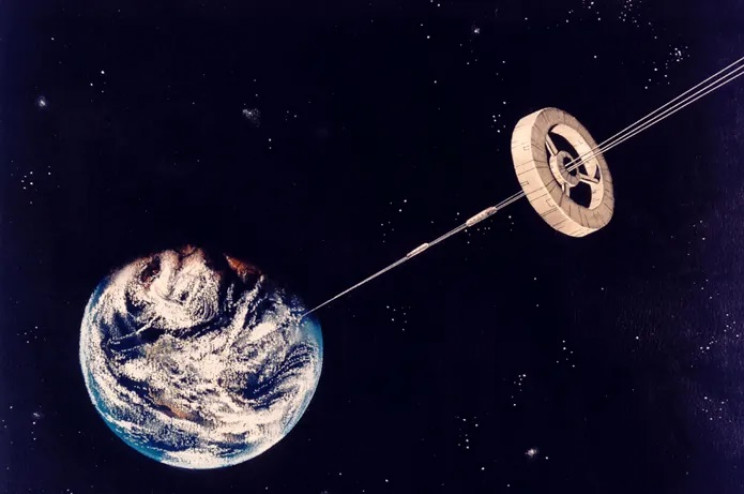
The lower gravity would also make it relatively cheap to launch payloads or spacecraft from the surface. On Mercury, vehicles would need to achieve an escape velocity of 12.14 ft/s² (3.70 m/s²), which is slightly more than 1/3rd Earth’s escape velocity. This would mean that ores and other resources could be launched into space relatively cheaply.
Similarly, a mobile platform could accommodate a Space Elevator, which would remain permanently suspended from the dark side of the planet. This would make launching payloads and passengers even cheaper, and the lower gravity would mean that the stresses placed upon the tether would be significantly less than a Space Elevator on Earth.
With some serious ingenuity, innovation, and imagination, millions of people might actually think of Mercury as home someday. Between settlements in the polar regions, stable lava tubes, and mobile operations on the dark side of the planet, Mercury could become an “adventure tourism” destination catering to folks who like a little danger (but still demand safety)!
It could also become the mining, manufacturing, and energy hub for human civilization, which could one day spread to every planet and moon in the Solar System. Who knows? Someday, the adjective “Hermian” could call to mind tough, rugged people who chose to live in one of the harshest environments in the Solar System!
* * *
“Thank you for visiting our world. We trust that you had an exciting time and we hope to see you again! Before you board the Spindle, be sure to visit the gift shop to pick up some souvenirs to commemorate your stay. Our duty-free prices cannot be matched!
“Looking for presents for family and off-worlders? Visit the art gallery to see our famous selection of artisanal sculptures. These decorative and interpretive works of ceramic, glass, and metal are hand-spun by local artisans. Hermian art is renowned across the Solar System, so in addition to supporting the local artistic community, you’ll be sharing the gift of beauty!
“A reminder to all those departing that radiation checks and physicals are recommended after departure. Please consult your medical practitioner or virtual doctor about scheduling appointments for the next six weeks. Be sure to monitor for any signs of radiation or gravity sickness, as re-acclimation to low-g and high-g can be difficult.
“Now that you’ve spent some time on our fair world, we hope that you agree: there’s no place in the System like Mercury!”

